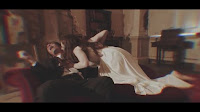Author: Calvin Cherry
First published: 2018
Contains spoilers
The Blurb: Dear reader,
When the boon of sleep becomes a presage of horror, while one’s long, shadowy days are laden with sordid events so terrifying they only bridge a thread to the same wicked nightmare, in what can a gentleman find refuge and catharsis? Writing.
No one can deny that Abraham Stoker penned a Gothic tour de force in 1897. All readers and moviegoers are familiar with the name
Dracula, as a parade of literary colleagues and Hollywood directors have probed the monster’s conscience for generations. Even so, few artists have explored Stoker’s motivations for creating such a loathsome, seductive protagonist. Welcome to Bram’s frightmare: a wild, historical tale that fuses the life and times of a struggling author, a ruthless prince, and vampire mythology.
Set in London in 1887, aspiring writer and stage manager Bram Stoker attends a séance that changes his life forever. What starts as an innocent ritual follows as a series of unforeseen yet connected plot twists and encounters with the bloodthirsty beast mistakenly freed from the underworld on that fateful night. As Bram’s young son Noel intervenes to pull his father from the madness that ensues, wife Florence’s health begins to decline, and his employer, actor Henry Irving, is being questioned about a violent murder that takes place outside his Lyceum Theater. To save careers, families, and souls, father and son seek answers to the darkest secrets hidden within the Carpathian Mountains, an ancient monastery, a ruined castle, and a forbidden cavern.
My Dracula prequel is meant to pay homage to a brilliant man, writer, and Romantic masterpiece, mixing fantasy, fact, and Gothic elements to show how literary art is born. I have been a vampire enthusiast since the tender age of seven, having first read Stoker’s work in comic-book form. Since then I have made it my avocation to study vampire lore, the historical Vlad the Impaler, as well as everything known about Bram. A vast amount of commentary on his novels, the same reference materials Stoker used in composing his works, as well as the author’s very notes and private journals inform my narrative.
The review: One thing I hate about reviewing material for the blog is looking at a person’s work and feeling no choice but to criticise. As such I hope author Calvin Cherry is true to his word at the end of this novel when he says, “
And when my writing is not of merit, I thank {God}
for the humble attitude to recognize this, seek and accept constructive criticism…” (p575) for the criticisms hereafter may not seem it but they are an endeavour to be constructive as this lengthy tome was clearly a labour of love and, whether in a revision or whether in a new piece of work, I would hope that the writer seeks to take that raw imagination and improve upon what was here. For it is an inventive work and it clearly took time and effort.
However, that didn’t help my experience as the reader. I’ll start, if I may, with language as I found myself wishing, early on, that the manuscript had been subjected to an editor’s red pen (or, if it had one, a better editor). The book is about the conceptualisation of the novel Dracula and places Stoker as the primary character, who finds himself under the scrutiny of Count Dracula (actually Vlad Ţepeş) and forced to learn about the vampire’s life in order that he might create a written record of it. The threats to Stoker’s family are enough to coerce his reluctant cooperation.
As such we are in Victorian England but there are turn of phrases that really didn’t fit, and brought this reader out of the suspension of disbelief. For instance, Noel Stoker tells his father he wishes to take something to ‘show and tell’, this is an Americanism and wasn’t a thing in the UK, thus it jars, likewise measurements are given in kilometres when Britain used miles (and uses them still. Indeed, in the majority of the 19th century the British exclusively used the Imperial system across the Empire, hence the name.)
The thing that really drew me away from the book, however, was the language characters used. It is important to give a character a voice, however giving them an accent might not be the answer especially if it reads like the prose version of Dick Van Dyke in Mary Poppins. There were some accents used and I would have avoided those altogether, but more so I would have utterly avoided the use of Shakespearean pronouns/variations when writing in the voice of the Count. Firstly, it made no sense – Ţepeş may have been an anachronism but his first language will have been Wallachian, not English. Therefore when learning English (whenever that was), he would have learnt the vernacular of the time and, if time had passed, certainly would have evolved his speaking as the language evolved (remember, Stoker suggests that the Count wishes to pass as a native and there certainly isn’t a “thee”, “thou” or “liveth” in his novel). But, beyond this, it felt clunky, stilted and was very inconsistently used.
I am also acutely aware that when reimagining history, one must take liberties and introduce changes. However, there are aspects also that one should try and get right. In the case of this book geography, for a starter. The handling of the geography around Whitby and London was poor. For instance, Bram is sent to Whitby to take passage to continental Europe (and returns to England through Whitby too, despite travelling from Le Havre and rushing back to his family). We could ask why; there were boats that will have sailed from London (as the Czarina Catherine did in Stoker’s novel) or the most obvious choice would have been to go to Dover (incidentally the original choice for Dracula’s landing in Stoker’s novel as per the notes) and on return perhaps even Portsmouth. Of course, that the author didn’t want to expunge Whitby altogether is the likely answer, but the use of the port for a planned trip to or from London is different to being blown there in the wilds of a storm. I wouldn’t expect the author to necessarily know that trains for the North East would leave Kings Cross and not Paddington (which is typo’d to Pennington at one point, incidentally). However, I would expect the author to realise that a train to Whitby would not stop at Portsmouth (or go anywhere near it), as it is in the opposite direction. All this can be quickly ascertained through a quick google map session and the same session could reveal that it takes approximately 5 hours in a modern car to travel from Whitby to London – not the 1 hour by coach as claimed later in the book.
Once at Whitby it is unlikely that the library would send a book (Wilkinson) overseas, especially on the request from a note put through the door when they were closed, but it is even less likely that the book would arrive before the passenger who set off the night before the library got the note. Wilkinson itself (available to view in
scanned form) famously only had two paragraphs and a footnote pertaining to Ţepeş (and his father), only mentioning the name Dracula and certainly did not include the Saxon woodcuts (as implied) or photographs (as stated). To this observation might come the retort that this volume is fiction and artistic licence has been used around Wilkinson. In response I would point that the official blurb states that Stoker’s reference materials inform this book’s narrative. I’d also suggest that, when merging fiction and fact, perhaps inventing a book that has the details you want as the author would be better, especially when dealing with artefacts that are well known to the community you are selling your product to.
Incidentally, on the same issue of maintaining a real-world voracity, Ţepeş was not born with that name (as the character herein claims more than once, for instance, “
My formal name is Prince Vlad Tepes Dracul – of Sighişoara, though most countrymen calleth me The Impaler.” p65 also "
I was born as Vlad Tepes" p143) and likely was never referred to by the soubriquet Ţepeş to his face. Of course, Ţepeş meant impaler, though the quote above implies otherwise. The author does address, much later in the book, why a Voivode (not Prince, as stated above) is now referred to by the lesser title of Count, but the reason is not satisfying (essentially because Satan said so). Back to locations, for a moment, and Slains Castle was far from ruined in the time frame presented (indeed it was an occupied residence) – and speaking of time frames, we only discover a jump in time towards the end of the book but the impact of that timeframe shift on the young characters’ ages (Noel and his friend Jonathan) is not addressed earlier, leaving them very young in the reader’s visualisation and up to things that children so young would never have gotten away with.
You might think I am being picky, but these were just examples from a long list of notes made and some of these things could have been answered through diligent research. However, the Americanisms, the errors of fact and geography, the clunky use of Shakespearean English and accents and the fact that the prose could be cumbersome in and of itself served to take this reader out of a story that brimmed with imagination and whose central conceit was interesting. This was the case to the point that I struggled to pick the book up rather than put it down.
3 out of 10.
In Paperback @ Amazon US
In Paperback @ Amazon UK



































































